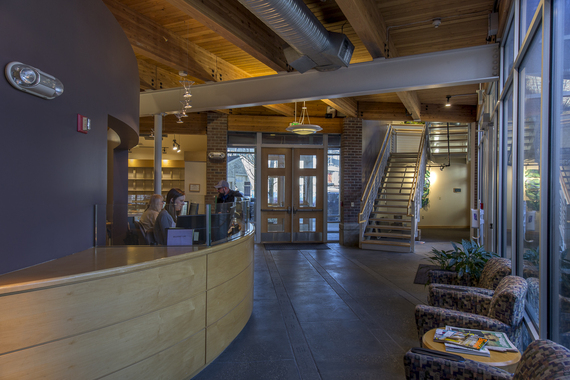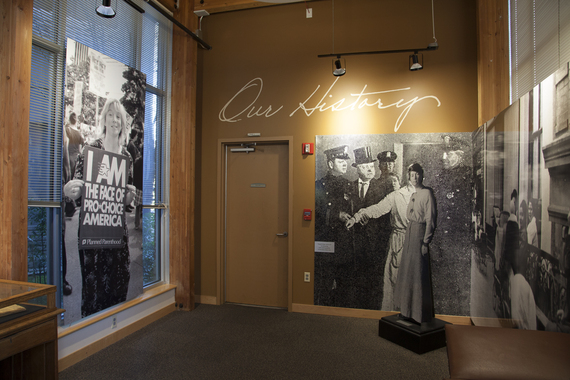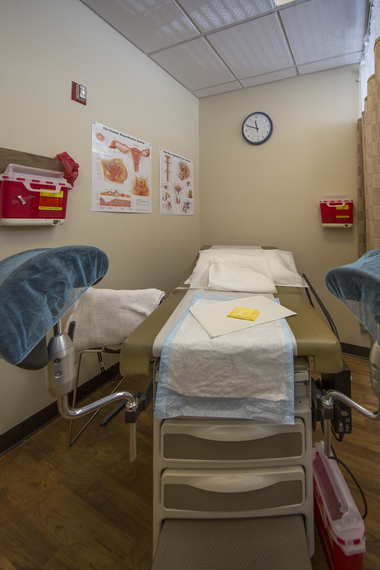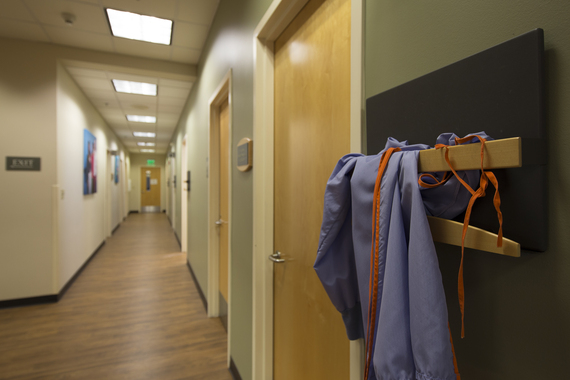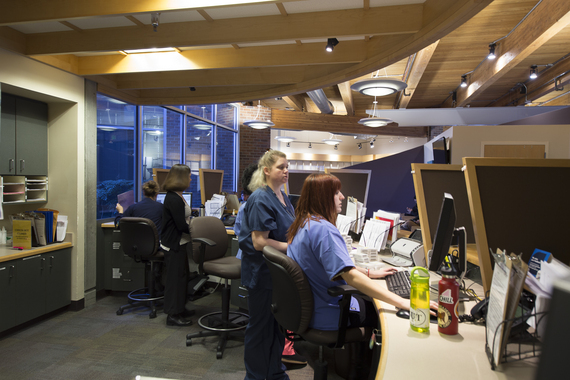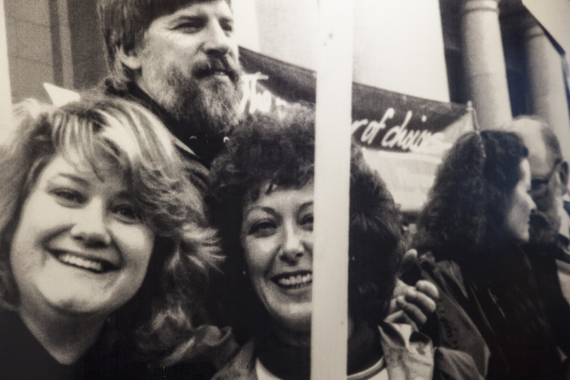 Christine Charbonneau, left, CEO, Planned Parenthood of the Great Northwest and Hawaiian Islands, "Fighting the Fight," Back in the Day
Christine Charbonneau, left, CEO, Planned Parenthood of the Great Northwest and Hawaiian Islands, "Fighting the Fight," Back in the Day
The state of women's rights in America--exacerbated by the results of the presidential election--recalls a science-fiction scenario, from Ray Bradbury's, 1951, "The Other Foot." This masterpiece, of eighteen short stories contained within the award-winning "Illustrated Man," is set in the Fifties. All African Americans have settled on Mars, after centuries of unspeakable cruelty on Earth. Twenty years have passed. Earth is in the throws of WWIII's nuclear ruin. One white man travels to Mars to ask for African Americans' forgiveness, along with a request for their return to Earth, to rescue the remaining (radioactive) whites. The elders want to exact revenge, but decide otherwise.
Perhaps the "moral majority" will someday arrive at the same conclusion, in understanding their horrid treatment of women (and of all minorities). And beg for forgiveness. One can only hope.
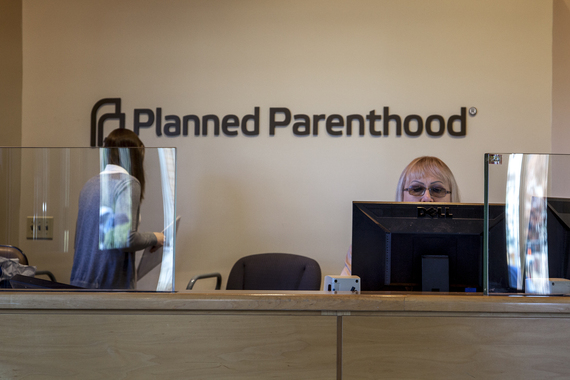 Seattle's Planned Parenthood Lobby, Photo Credit: Kelvin Hughes Productions http://www.kelvinhughesproductions.com
Seattle's Planned Parenthood Lobby, Photo Credit: Kelvin Hughes Productions http://www.kelvinhughesproductions.com
Fighting for women's rights, virtually her entire life, is Christine Charbonneau, 56, CEO of Planned Parenthood of the Great Northwest and Hawaiian Islands (PPGNHI). PPGNHI is a 500-strong, 51-million-dollar a year, not-for-profit organization that serves more than 100,000 clients in 28 health care sites across four states, including Washington, Idaho, Alaska, and Hawaii. Planned Parenthood is devoted to all aspects of reproductive health services, including sexual education and cancer screenings. And, yes, 3% (nationwide) includes abortion, or as Charbonneau put it, "The most private decision a woman, and partner, will ever make."
Charbonneau began her inspired-and-inspiring career path with Seattle's Planned Parenthood in 1982, at age 22. But her journey to protect women's rights was set in motion at age 11.
In 1971, her father, an international banker, moved his family to Zurich, Switzerland, to run Seattle's (former) Old National Bank. Switzerland's women's right to vote was in the midst of a hot debate. (The same year it became legal in Mbazwana, South Africa). "I remember asking my mother why grocery/department store bags everywhere, had imprinted on them: 'Frauen Wahlrecht ja' [Women's Right to Vote: Yes!]," Charbonneau said. "It was embarrassing to the country, because the U.S. had the 19th Amendment and other places in the world had settled it. But, Swiss women still couldn't vote in federal elections. And they had to fix it, because it had turned into human rights abuses, and so every major store was in on the campaign." She said the signs appeared everywhere, and likened it to The Bon and Nordstrom advertising it on their bags. "I kept asking my mother, 'What does this mean?'," Charbonneau continued. "I realized I was living in a place where women couldn't vote. It would be akin to growing up in the 1900s in the U.S. and suddenly it was as if we're having a debate if women had souls or not. I realized that women get--and hang on to--our rights by the absolute tips of our fingers," she said. "There is no time anyone will hand women anything, and there is no time when you can't be vigilant about it."
In due course, while studying history and political science at the University of Washington, Charbonneau gained a first-hand look at the plight of Seattle's (inner-city) Planned Parenthood. For one Tuesday a week, she volunteered four-to-six hours a day, to help people access contraception. "I was absolutely clear that if women didn't have contraception, they couldn't finish their academic goals," she said. "You, in fact, could not control your destiny, and your body would not be your own."
Her memories of the old Planned Parenthood, stand in bleak contrast to the new-and-improved Planned Parenthood of the Great Northwest and Hawaiian Islands. Her first office location, now in a gentrified Seattle neighborhood, is just one block away from PPGNHI's current, beautifully appointed office building, made possible by the community's 18-month, seven-million dollar, capital campaign. [See photo inserts.] "It was an old Albertsons, an A-shaped place with windows only in front, and burnt-orange and olive-colored furniture and counter tops, [favored] in the 60s and 70s," she said. Still, it was a "vast improvement" from their variety of former storefronts, and makeshift locations. "Before my time, they would set up a clinic so women and volunteer doctors would show up," she said, "and they'd set up curtains and people would get served one after the other. But I don't think any privacy would have met our standards today." 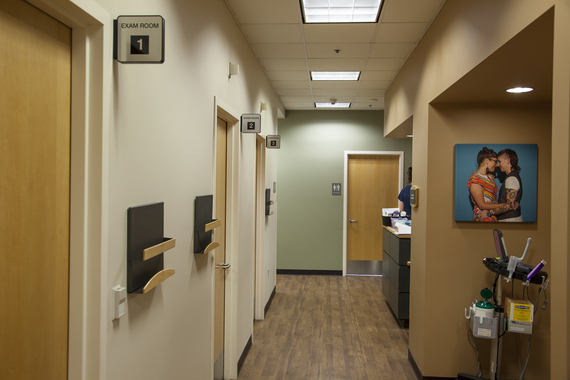 Planned Parenthood today, Photo Credit: Kelvin Hughes Productions
Planned Parenthood today, Photo Credit: Kelvin Hughes Productions
With fewer legal requirements and methods, she said, it was less complicated back then, because PP mainly only offered diaphragms and pills. However, women had to "qualify" for tubal ligations--if enough money existed for one. One-month counseling sessions were commonplace. "We wanted to separate the movement from any exploitation that had gone on in the past, where women were sterilized in mental institutions and hospitals," she said. "We wanted to differentiate ourselves from that, and ensure that women were doing this on their own free will."
Charbonneau said she never imagined that women would have to fight an every day battle for Roe v. Wade (a 1973 landmark decision by the United States Supreme Court, that ruled a right to privacy under the Due Process Clause of the 14th Amendment extended to a woman's right to have an abortion). "I was very young, 13, when it passed, so I didn't have personal experience with women dying, but I sure heard of women's experiences," she said.
"There was a 40-year-old woman with an unimaginable circumstance, and the solution, because abortion was illegal, she was given a hysterectomy, and I remember thinking there was so much wrong with that."
Pre Roe v. Wade, as is well documented, clandestine abortions became the norm, resulting in women seeking self-induced, or dangerous, illegal procedures--often leading to death. The death rates were staggering. But, for wealthy women, the scenario was different. According to Charbonneau, in 1969, a Seattle [Japanese/American-owned] travel company, every Friday, filled a chartered 747 with women and headed to Tokyo, where abortions were legal.
"They'd go to Tokyo, have abortions by doctors, go to a few Shinto shrines, pick up some souvenirs, and pretend they did a weekend jaunt to Japan, for fun," Charbonneau said. "It cost $1700, which was a truckload of money back then. That's how the rich women did it. Poor women did scarier stuff."
The scarier stuff, according to Charbonneau, often resulted in "septic abortions" that accounted for 40% of U.S. hospital admissions. (The New England Journal of Medicine, describes septic abortion as "an abortion associated with infection and complicated by fever, endometritis, and parametritis." It remains one of the most serious threats to women's health, worldwide.)
Charbonneau holds vivid memories, as a young adult, marching alongside "Emergency Room Physicians for Choice," who witnessed that dark period in U.S. history. "They put themselves out there, " she said.
"They were all doctors who were first line when people came in, and they were talking about women bleeding to death in their hands, and how completely unacceptable that was. They were all men who were at the top of their careers prior to Roe. They were the ones called in and asked 'Can you save her?', and sometimes they could, but a lot of times they couldn't. The physicians said they never want to go back to that."
If you were part of the World Health Organization--and measuring the most important advances in women's health care--safe legal abortions would top the list, Charbonneau believes.
"Younger emergency doctors don't have any history of this other than what they're told," she said. "Rather than taking care of the car accident victims, you'd be dealing with young women dying in the ER. That's what happens when people's access to care is inaccessible or illegal. It's not that those things don't happen anymore; but they can be avoided. They had to do care that people don't learn how to do now, because that's not the situation. We got rid of it, but we need to remember so we don't go back. That was their reason for standing up. They were in their doctor scrubs and explaining what it was like in the past."
The legalization of abortion, according to Charbonneau, started with an outbreak of German Measles (Rubella) in the United States, in the early-to-mid 60s. "You were stuck as a family," she said. "If things went wrong with a pregnancy, and you had a dead fetus inside of you, you could have for months, while it slowly killed you." A political movement ensued to get abortion passed, and once it did, everyone involved thought it was a done. But, then the "Right to Life" movement was born. "At first they did ineffective things," Charbonneau said, "but then they came up with smarter ways to make it more difficult for women to get care."
Along those lines, however, the Supreme Court recently overturned Whole Woman's Health et al. v. Hellerstedt, Commissioner, Texas Department of State Health Services, et al https://www.supremecourt.gov/opinions/15pdf/15-274_p8k0.pdf. If upheld, it would have required for physicians who perform abortions to have admitting privileges; live within a certain radius of a hospital; and for abortion clinics to have facilities "comparable to an ambulatory surgical center." The case became a "political nightmare," according to Charbonneau, and, [before it was overturned], was used in places, like Mississippi, where everyone could be easily pressured never to grant admitting privileges.
"There were things like mandatory 12-foot hallways," she said. "The conditions had to be good enough for neuro surgery, even if you were just handing patients pills. We saw mandatory ultrasounds, even though your doctor doesn't think you need one, but the legislature does," she continued. "It was absolutely invasive, outrageous things that were decided so they could punish women if they decided they needed an abortion."
Charbonneau believes that the attempted restrictions on abortion posed in Whole Woman's Health v. Hellerstedt stems from a long line of that kind of thinking. "There are people who are really angry with women who dare to determine her own reproduction choices, let alone run for president," she said. "It's the old double standard," she continued. "Hillary is responsible for Bill's affairs; he is not." At the same time, she said, the entire Right to Life movement--which she calls the "Anti-choice Movement"--refuses to support sexuality education. "There is much less chance of an unintended pregnancy if you know what are your risks, and a way to think through your plan in a situation like that," she said.
"I think that, weirdly, if you were interested in avoiding unintended pregnancy, you would want people to have education, and highly effective contraception methods."
One aspect in which the general public is not clear, according to Charbonneau, is the success of contraceptives. "We used to have the same methods for years," she said. "And now we have implants, and IUD devices that are available to young women," she continued, "because back in the day, we only put IUDs in women who were done childbearing, in case of any complications. But those problems have been sorted out." She reported that they're now appropriate for young women, and have a 99.9% effectiveness rating, and can be left in for five to ten years.
"It's like the proverbial on/off switch, that many of us wish we had in college," she said. "Young women can now say, 'I'm going to college, I don't want to think about this, I have this plan in my life, I don't want to take any risks, and at the same time, I know that these methods are 100% reversible.' If women want to finish college, then have a baby right away, it can absolutely happen. Everything is within a woman's control, and nothing is permanent. So if your life changes course, you can change course with it."
Favorably, unintended pregnancy rates are down one half since Charbonneau began at PP, in 1982. "Pregnancy rates were very high in the 1950s; came down with oral contraceptives; and then didn't come down again for years," she said. "The numbers moved a bit with effective morning after treatment, Plan B, but no significant change until the introduction of long-acting, reversible methods."
She attributes the success of contraception to better conversations, leading to better education. "We used to have people come in who said they didn't know how they got pregnant," she said. "There are really good tools now if you don't want to get pregnant. If you want to use pills, you can set it and forget it. That's kind of nice."
As an example of exemplary sexuality education, Charbonneau commended the "wonderfully open, progressive" state of Hawaii. PPGNHI was instrumental in passing a sexual education bill that provides medically accurate sexuality education for every student in Hawaii. "If parents don't want their children in the program, they don't have to opt them in, they have to opt them out."
Planned Parenthood's answer to societal pressure on schools to teach sexual education, is to provide it online, at PP.org http://pp.org. In privacy, parents and kids alike can click around on the site and receive a lot of information. "We have help for parents of how to talk with their kids," Charbonneau said.
"A lot of parents don't feel confident, but we help build their confidence, and offer ways to start the conversation, and what they should cover."
She continued that PP is "on the cusp" of advancing sexual education. "We can put ourselves out there and reach out to people who are looking for information," she said, "and meet people 'in the cloud,' and people living in remote areas, and we can find ways to serve them. It won't just be the luxury of urban, knowledgeable women. It can be anyone, anywhere. That's what's exciting to me."
What's next for Charbonneau...
"I am an immigrant to technology," Charbonneau said. "Younger people are natives, and it's obvious to them what to do. I'm thinking that over time, I can learn what is relevant from the people who work with me. But at some point, I'm looking forward to not understanding what my staff tells me needs to be done, and then I'll know it's time to do something else, and leave the innovation to the next generation."
Meanwhile, Planned Parenthood continues to try to solve the puzzle of how to best-serve those hardest to serve. Currently, they're in the process of setting up a joint company that offers tele-medicine services in all 50 states. "We piloted the program in Seattle, and we are doubling our numbers every month," she said." We've now passed the 3,000 served mark, so the word is getting out!" Patients can now visit with a clinician online, or on their smart phone, to discuss their concerns, and access birth control, and/or an STD testing kit, without ever leaving the comfort of, whatever are their surroundings. "One aspect that's frustrating," Charbonneau said, "is that Medicaid is slow to embrace tele-medicine; but, as soon as they do, we will have a real service to offer to low income people."
https://www.youtube.com/watch?v=kfwOTV7eJ1Y&feature=youtu.be
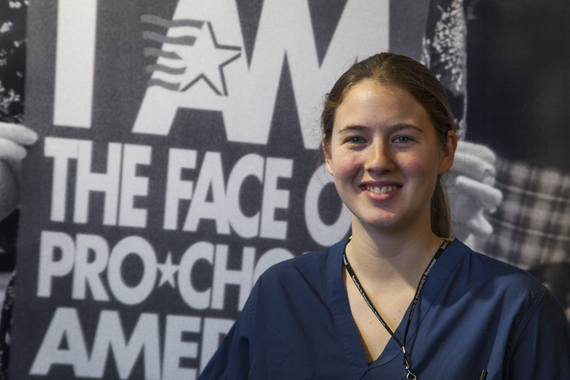 Natalie, former PPGNHI Patient Care Specialist, now at medical school. Photo Credit: Kelvin Hughes Productions
Natalie, former PPGNHI Patient Care Specialist, now at medical school. Photo Credit: Kelvin Hughes Productions
For this generation, Charbonneau hopes they'll have a better understanding of the most personal issues that people deal with--without the fear and trepidation that come with fundamental life issues.
"There is a place where nothing is quite like somebody who cares, in helping in some real way, whatever form that takes to help you know what to do next," she said. "I'd like Planned Parenthood to end up with a real combination of every smart thing that makes us super efficient, and technological, coupled with the warmest, kindest approach to what is frightening that we can muster."
Back in her early days of volunteering, Charbonneau recalls, "We were like everybody's oldest sister, that you needed to know." She doesn't want that lost.
"In women's reproductive care," she continued, "where you're naked, undressed and vulnerable--and things like death and dying, or for some people, handling money--it's places like that, where it's about survival-and-your-identity that need to be handled delicately. Keep humanity, so everyone has access. We have to make sure we cover things women need. At the end of the day, we're a community of people together. We want to take care of each other."
